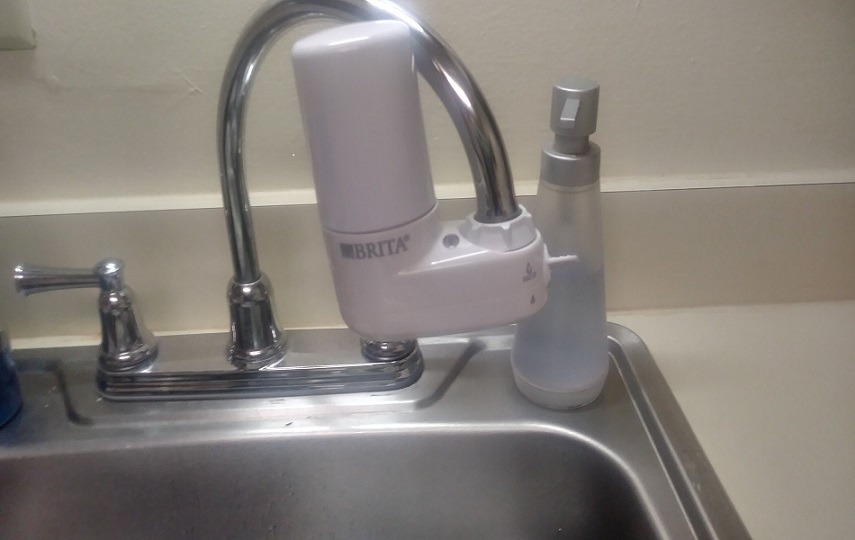When I bought the Brita Water Treatment Filter, I knew I was getting a reputable product that has been around in the water filter business for well over a decade. What I got was a crystal clear tasty glass of water until I bypassed the filter to use the untreated water from the faucet and saw that the water had turned to the color of milk, which never happened until I installed the filter. What is this Brita Faucet Filter’s milky water mystery?
When the Brita Faucet Filter is put on its by-pass, H2O runs through 2 aerators in the system that saturate the water with dissolved oxygen; the Colder the H2O, the more oxygen it holds. With added colder seasonal temperatures, the water creates white cloudiness that is oxygen trapped in the solution.
Because of what I knew about other water filtering systems, most filters are filled with different types of media that, after manufacturing, need to be flushed or rinsed and primed; my first instinct was that I didn’t do this before I assembled the faucet filter. But soon after, it was easy to reach a conclusion on the mystery. Here is what I found out.
How Effective Are Brita Filters
Having owned the Brita Filter made your faucet for a few weeks now, I can honestly say my water does taste better. I am drinking more than ever, but then again, I do prefer water to anything else besides a cold beer. The filter was easy to assemble onto the faucet, and it is easy to remove and swap the filters; they snap and turn into place and seal tight with no spraying or leaking.
The size is good for using the kitchen sink without banging into it and maneuvering around without using a double sink. We have no big problems at dinnertime. I can remove it and put it back on for whatever reason, and the plastic coupling will go on and come off very easily. It’s nicely constructed and looks good.
The filter is good for treating up to 100 gallons and comes with an indicator light that lets you know that it’s time to swap the filter by blinking red from the green color. The Brita Faucet Filtration System removes 99% of lead and reduces chlorine (taste and odor), benzene, asbestos, and trichloroethylene, all of which may be found in tap water.
In fact, the Brita removes 60 recognized contaminants, including 99% of the contaminated Lead. The Compatible Replacement Filter is fairly inexpensive, and the company has a locator online that will show you where to pick one up fast with the latest price, which is under 20 bucks for the Standard Brita Cost around $30.00
WATER QUALITY ASSOCIATION 

System tested and certified by the WQA against NSF/ANSI Standards 42 and 53 for the reduction of the claims specified on the Performance Data Sheet. Residential drinking water filters are covered by two industry standards: NSF/ANSI Standard 42 and NSF/ANSI Standard 53. The standards are identical when it comes to evaluating the material’s safety and structural integrity of a filtration system if connected to a pressurized supply, but each standard covers a different type of chemical reduction performance testing.
Standard 42 covers aesthetic (taste and odor) claims, while Standard 53 addresses health-related claims. Although both standards cover drinking water filters, the methods of performance testing found in the standards vary.
Brita Water Filter (Faucet) Reviews- Most reviews from Consumers Affairs for the Faucet Brita were very good on the quality and the replacement cartridges that you can buy. There are some complaints about the Water Filter Pitcher that Brita sells that were written on the product a few years ago. My object was to come up with a logical reason why the water coming from mine and other people’s faucets became milky colored once a Brita Faucet Water Filter was installed at the sink.
Why is My Filtered Water Cloudy
After installing the Brita Water Filter on my kitchen sink, I notice something not subtle at all. My drinking water at the faucet was white milky colored This happened with the Brita bypass on, and no water was moving through the filter. I was quite perplexed.
I am considered somewhat of an expert on water from the years of experience who have treated it and written about it for a living. This was a mystery that I would get to the bottom of. I decided to try a few things to figure out what was happening.
I started by checking other points of the source where water comes in. Troubleshoot the system just in case I did something wrong when I assembled the Brita Faucet Filter. I have other filters that require flushing the filter media before using them. For the Berkey I have, I needed to flush, rinse, and prime filters inside the Gravity Filter when assembling the system.
Most filters have the requirement to rinse the residue on media that needs to be cleaned before you start using them. Once I determined the milky water was coming from only one source, which was the kitchen,
- I went over the instructions, then took it off the faucet and ran the water, and just like that, the milkiness was gone and clear as a bell.
- I re-seated the filter and reinstalled it on the faucet, and tried it again.
- The water that ran through the filter was crystal clear, but when I turned on the bypass and ran the water through the filter, it was milky again.
What is the Best Way to Filter Well Water?
Use a Whole House Water Filtration system that contains:
- Pre-Filter Sediment Removal
- Water Softener
- Carbon Filter (kills Bacteria)
- Pre-micro-sediment
- Reverse Osmosis-(Dissolved Contaminants to .01 microns in size)
- Polishing-Coconut Fiber-UV treatment (kills Virus & Cyst)
- Minerals-added that were stripped ..………………………………………………………………………………. Read more
The Solution Of The Brita Filters Milky Water Mystery
The Brita Water Filter for your faucet is a good reputable filtering system that easily attaches to your kitchen faucet that removes chlorine, lead, and other contaminants while improving the taste of your drinking water. One complaint that has been coming up is the milky appearance of the water when using the bypass on the filter. The result is a simple principle of the science of temperature, water, and air. Cold water can hold more dissolved oxygen than warm water.
Shower Head Filters using Carbon/KDF media can deplete Chlorine residual, making it feel better & less harsh. Chlorine, a known carcinogenic is bad for skin & hair but Shower Head Filters do little to soften Hardness in H2O because of the little time of contact it has with media through the filter ……………………………………………………… Read more
In Nature, Dissolved oxygen will enter the water through the air or as a plant byproduct. From the air, oxygen can slowly diffuse across the water’s surface from the surrounding atmosphere or be mixed in quickly through aeration, whether natural or man-made. The aeration of water can be caused by wind (creating waves), rapids, waterfalls, groundwater discharge, or other forms of running water. Man-made causes of aeration vary from an aquarium air pump to a hand-turned waterwheel to a large dam.
What are the Best Countertop Water Filtration Systems?
- The Zip Countertop Reverse Osmosis Water Filter
- The Big Berkey
- The AquaTru Countertop Water Purification System .…………………………………… Read more
JimGalloway Author/Editor


